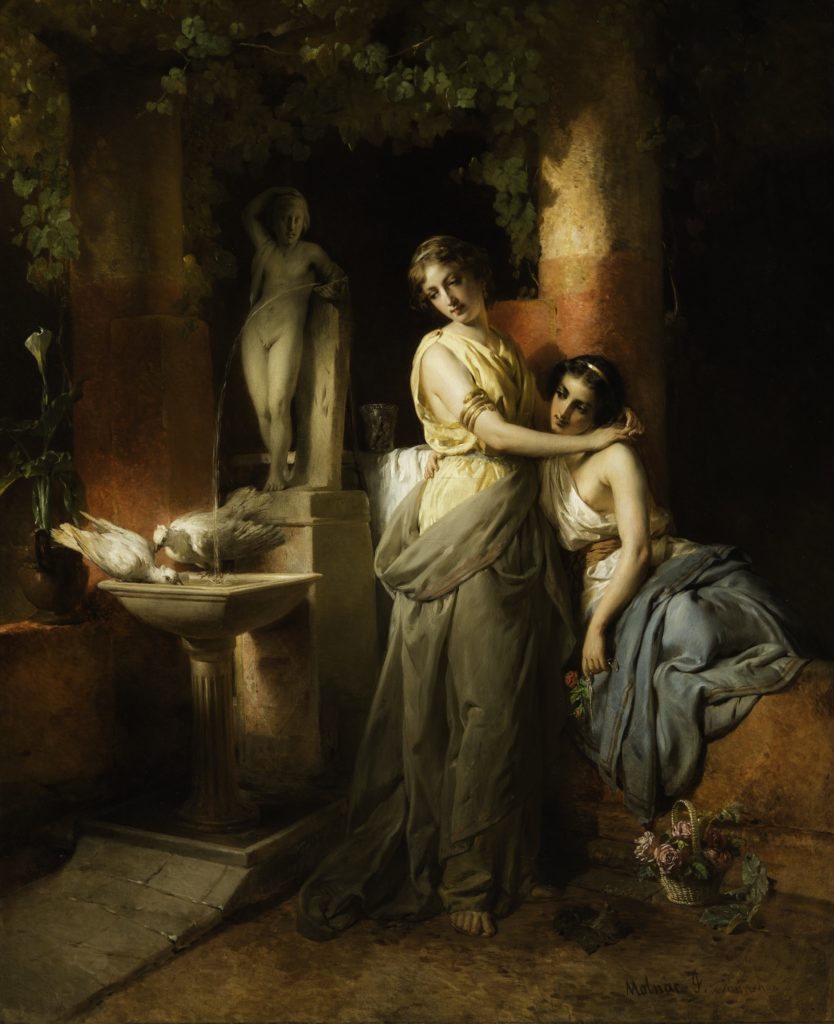We use cookies to provide you with the best possible service and a user-friendly website.
Please find our Privacy Policy on data protection and data management here
Please find more information on the cookies here
We are approaching the end of March and the birthday of the least known masters of nineteenth-century Hungarian painting, who captured the landscapes of Lake Balaton and those around Pest in stunning compositions while also being an excellent portraitist, one of the first Hungarian students of Károly Markó and a painter, who left behind a lasting oeuvre of historical and genre painting: he was called József Molnár. It does not ring a bell, does it? So it’s time to remember it.

József Molnár: Idyll in Pompeii, mid-1870s, oil on canvas, 117 × 95 cm, Hungarian National Gallery
József Molnár was born on 21 March 1821 in Zsámbok (and not in Zsámbék, as it can be often read), near Gödöllő. He went to school in Bicske (short for Tápióbicske, and to be confused with Bicske, which is near Zsámbék), close to the village of his birth. He began to study painting in 1837 at the Academy in Vienna and lived abroad – with smaller interruptions – until he returned and settled in his native Hungary in 1853. He died in Budapest in 1899. His stay at Károly Markó’s house in Florence in 1845 must have been a defining inspiration for him. He made a portrait of Markó in 1845: it is a great loss in Hungarian art history that the whereabouts of this painting is not known and no photograph of it exists. Only a few portraits were made of Markó, so it must have been an occasion of special significance that the master was willing to sit as a model for his young student in 1845.
Molnár’s commitment to the cause of national art is best exemplified by the fact that he was always the first to respond to the questions addressed to all Hungarian artists by Ágoston Kubinyi, the director of the National Museum. Kubinyi turned to Hungarian artists, asking them to send him their autobiography, a portrait and another work, with the aim of augmenting, or rather laying the foundations for the collections of his museum. It says volumes about those times that apart from Jakab Marastoni and Frigyes Lieder – both of foreign descent – Molnár was the only Hungarian artist who sent his self-portrait to the museum in 1850 immediately upon receiving the director’s request.
After the historical paintings of the 1850s, Molnár soon discovered the potential inherent in genre scenes. He was one of the first artists whose genre painting was not linked to the national sentiment and its themes and moved towards a more romantic, adventurous and universal expression. What makes his painting especially unique, however, is that the protagonists of his genre scenes are predominantly women. They appear in his modern urban genre pictures, his scenes set on the shores of Lake Balaton; the same beautiful woman with a longish face recurs in his painting set amidst the historical environment of ancient Pompeii.
One of Molnár’s largest-scale cycles features the ancient Italian city of Pompeii, which was destroyed by the eruption of Vesuvius in the summer of 79 AD. The city, buried under several metres of volcanic ash, was discovered only one and a half thousand years later. Since the excavation of the ruins lasted more than a century, shocking finds were discovered even in the 1860s and 1870s (including the petrified imprints of people who suffocated under the ashes); and it was around this time that Molnár began to take an interest in the destruction of Pompeii. He painted several genre pictures featuring life in Pompeii; in 1876 he completed a monumental genre scene (approx. 3 × 4 metres) depicting the disaster of Pompeii.
The unique ambiance of his composition depicting two women in Pompeii is created by the melancholy and dreamy gaze of the figures. The modern viewer cannot forget that Pompeii is the symbol of tragically sudden and inevitable end; thus the female characters convey both the magic of eternal beauty and the sadness of transience.
20 March 2019
Click here to read more from the serie.


